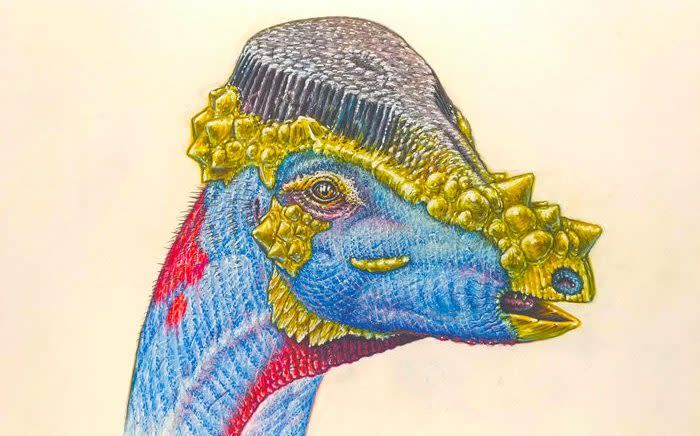Dinosaur with ‘toothbrushes bristles’ on its head discovered

A new dinosaur that had rows of tough bristles like a toothbrush on its head has been discovered.
Researchers say the dome-headed dino from 68 million years ago has traces of keratin, what fingernails are made of, sticking up from its skull.
Palaeontologists say Platytholus clemensi, a type of pachycephalosaur was a plant-eating dinosaur that grew up to 15 feet long and walked on two legs.
Discovered in 2011 in Montana’s Hell Creek Formation, the partial skull has now undergone CT scans that have revealed the keratin bristles, described as looking like a “brush cut”.
Dinosaur skulls sport an amazing variety of bony ornaments, ranging from the horns of Triceratops and the mohawk-like crests of hadrosaurs to the bumps and knobs covering the head of Tyrannosaurus rex.
There is a theory that the type of dinosaurs that pachycephalosaurs belonged to bashed heads in courtship rituals much like some mammals do today.
But despite a gash being discovered on the skull which had healed up, the researchers say there is no real evidence to back this up and the discovery of bristles point to more of an elaborate headdress.
‘It’s all about display’
Dr Mark Goodwin of the University of California, Berkeley, said: “We don’t know the exact shape of what was covering the dome, but it had this vertical component that we interpret as covered with keratin.
“A bristly, flat-topped covering biologically makes sense. Animals change or use certain features, particularly on the skull, for multiple functions.
“It could be for display or for social and biological interactions involving visual communication.”
Professor Jack Horner, who was the inspiration for the Dr Alan Grant character in Jurassic Park, added: “I would guess that there was something pretty elaborate up there.”
The head wound is about half an inch deep but they say it could have been caused by anything from a falling rock to a chance encounter with a tree or another dinosaur.
Prof Horner said: “Something hit the top of this guy’s head and damaged it, and it was something that was severe.
“But having a defence mechanism on your head is not a good idea, not for anybody.
“Any features, any accoutrements that we find on the heads of dinosaurs, I think, are all display - it’s all about display.”
Brightly coloured
The study in the Journal of Vertebrate Paleontology said blood vessels in the skull ended abruptly at the surface of the dome, indicating that the blood originally fed some tissue that was sitting atop the dome.
And as the vessels were perpendicular to the surface they most likely fed a vertical structure.
Prof Horner added: “What we see are these vertical canals coming to the surface, which suggests that there might be keratin on top, but it’s oriented vertically.
“I think these pachycephalosaurs had something on top of their head that we don’t know about. I don’t think they were just domes. I think there was some elaborate display on top of their head.”
Dr Goodwin continued: “It’s reasonable to suggest that the covering over the dome may also have been brightly coloured or subject to colour change seasonally.
“We know the dome was covered with something, and we make a hypothesis that it had a vertical structural component, unlike Triceratops, T. rex and other dinosaurs, which had hard skin or keratin closely covering the bone.”
Dr Goodwin also noted that the shape of the domed heads of pachycephalosaurs changed as the animals matured, becoming more prominent and elaborate as they approached adulthood.
That, too, would suggest they were used for sexual display and courting, though they may have been used to butt the flanks, as opposed to the heads, of male rivals.
He suspects that dinosaurs likely distinguished gender by colour, as do most modern birds, such as cassowaries, peafowls and toucans, which have bright integumental colours around the face and head for visual communication.

 Yahoo News
Yahoo News 
